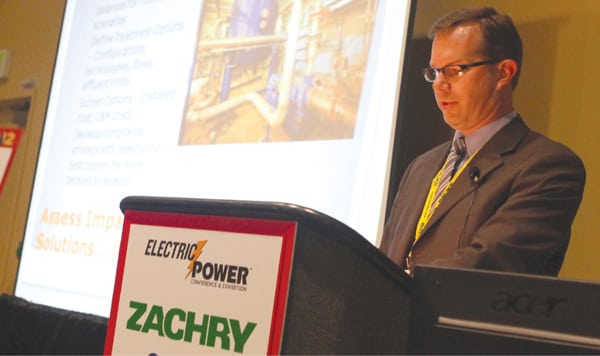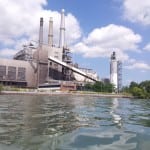Efforts by power producers to meet clean air rules mean that wastewater effluent streams now face revised EPA regulations. A skirmish involving a New Hampshire power plant could set the tone for the next battle over regulations.
U.S. coal-fired power plants with wet flue gas desulfurization (WFGD) systems can expect revised Environmental Protection Agency (EPA) rules aimed at reducing water pollution that results from operating that equipment.
The EPA decided in 2009 it was time to revise 1982-vintage rules on effluent water discharge from a range of power plant operations. The 30-year-old rules are inadequate to address current volumes of wastewater generated by WFGD systems. The rules that the EPA is expected to release for comment this November may well be based in large part on wastewater treatment systems installed at Duke Energy facilities in North Carolina and mandated as part of a draft National Pollutant Discharge Elimination Systems (NPDES) permit the EPA wrote for a New Hampshire power plant.
A conference session at ELECTRIC POWER in May discussed power plant water data collection techniques and treatment strategies but stopped short of speculating on what the revised EPA rules could require.
“The rules may be classified as unknown and causing uncertainty,” said Samuel R. Barnes, vice president of power generation and energy at Commonwealth Associates, who spoke during the conference (Figure 1). He told audience members that wastewater treatment systems in place since 2009 at Duke Energy’s 2,240-MW Belews Creek Station and 1,140-MW Allen Steam Station in North Carolina could be a model for the EPA’s revised standards, likely to take effect in 2014.
 |
| 1. Samuel R. Barnes. Barnes, vice president of power generation and energy at Commonwealth Associates, said expected EPA rules on effluent treatment may be classified as “unknown and causing uncertainty.” Source: POWER |
The Belews Creek treatment system uses a biological reactor system from GE to increase selenium removal from effluent streams. Duke Energy and Progress Energy cooperated in testing the Belews Creek system, as well as similar systems at other power plants in North Carolina—including the Allen Steam Station—that were installed to comply with state air quality rules.
The EPA specifically mentioned the Belews Creek and Allan Steam Station water treatment systems late last year when it issued a draft NPDES permit for Public Service of New Hampshire’s (PSNH’s) 440-MW coal-fired Merrimack Station and its WFGD effluent stream. In 2006, the New Hampshire legislature passed a law requiring PSNH to install and operate a WFGD at Merrimack Station to reduce air emissions of mercury and other pollutants by at least 80%.
To meet the law, PSNH installed (at a cost of $430 million) a physical/chemical FGD treatment system at Merrimack Station similar to those in place at the Duke Energy stations. The FGD treatment consists of one-stage chemical precipitation/iron co-precipitation system. In the draft NPDES permit, which was 14 years in the making, the EPA drew similarities between the Merrimack and Duke Energy plants in that they are coalâ€fired units that burn bituminous coal and operate limestone forced-oxidation WFGD systems, producing a commercialâ€grade gypsum byproduct. The Allen and Belews Creek treatment systems go a step further and include an anoxic/anaerobic biological treatment stage designed to optimize selenium removal.
PSNH selected a physical/chemical treatment system for the Merrimack Station’s FGD wastewater purge stream. Generally, a physical/chemical wastewater treatment system consists of chemical precipitation, coagulation/flocculation, clarification, filtration, and sludge dewatering. The Merrimack Station system will be supplemented with adsorbent media (or a “polishing step”) to remove still more mercury from the effluent.
PSNH considered at least 11 FGD wastewater treatment technologies, including discharge to a publicly owned treatment facility, evaporation ponds, flue gas injection, fixation, deep well injection, effluent reuse/recycling, settling ponds, treatment by the existing water treatment system, vapor-compression evaporation, physical/chemical treatment, and physical/chemical with added biological stage. The utility rejected all for use at the Merrimack Station, except for physical/chemical treatment.
The EPA said it considered biological treatment—specifically, physical/chemical treatment coupled with biological treatment—an adequately proven technology suitable for designation as best available technology (BAT) for Merrimack Station’s FGD treatment system. Biological treatment typically consists of a bioreactor tank/chamber, nutrient storage, a heat exchanger, a solids removal device, pumps, and associated equipment. To add biological treatment to the FGD wastewater treatment system, the EPA said Merrimack Station would need to install treatment tanks and process equipment and connect it with the physical/chemical treatment system.
Dismay
The New Hampshire utility did not agree, however, with the EPA’s conclusions. In a February 2012 news release objecting to the EPA’s draft permit, PSNH said, “Surprisingly, those existing systems are incapable of meeting the stringent limits EPA included in PSNH’s permit. In fact, given the same limits proposed for Merrimack Station, the Duke plants would have violated the limits more than 450 times during the previous three years.”
Gary Long, PSNH president and COO, was quoted in the release as saying, “This biological treatment is not necessary at Merrimack Station due to the comprehensive treatment systems that are already in place. I am dismayed that EPA would require installation of a $20+ million system that cannot meet the very limits EPA has set.”
(A Duke Energy spokesperson said the Belews Creek system “continues to perform very well for selenium,” but declined further comment.)
In its formal 230-page reply to the draft permit, PSNH said the EPA failed to properly consider the type of coal used, the specific characteristics of the waste stream (for example, levels of nitrogen, bromides, chlorides and dissolved solids), the oxidation-reduction potential in the scrubber, costs, and other factors unique to Merrimack Station.
“Eventually, EPA based its effluent limits on its erroneous determination that PSNH’s current physical/chemical system and polishing step, combined with the EPA proposed additional step of biological treatment, represented BAT for Merrimack Station,” the utility said in its reply. “Each of these limits, however, is unsupported and unlawful.”
Orders of Magnitude
In separate comments filed with the EPA, the Electric Power Research Institute (EPRI) said the agency’s estimated benefits for biological treatment are high compared with EPRI’s calculations. EPRI said that while multiple approaches exist for calculating total pounds of pollutants removed, its estimates were “consistently two orders of magnitude less” than the EPA’s estimates for biological treatment.
The EPA estimated the annualized costs at almost $4.9 million in capital investment and $430,000 in yearly operating and maintenance expense. It estimated the cost of adding biological treatment at Merrimack Station at around $5 million in capital and nearly $300,000 in annual operating and maintenance expense.
EPRI pegged the total capital cost for physical/chemical treatment at $18 million. It said total capital cost for biological treatment could run $10.5 million. And PSNH said in its reply the total cost of the EPA-mandated system could run to as much as $23 million.
The New Hampshire utility said the Allen Steam and Belews Creek stations vary greatly from Merrimack Station in that they have an FGD purge stream on the order of 400 to 600 gallons/minute, while Merrimack Station’s FGD purge stream is 50 gallons/minute. PSNH also said Merrimack Station’s physical/chemical treatment facility has minimal capacity to process additional effluent from bioreactors. It said other differences include changes to the purge stream based on coal types, boiler design and operation, scrubber operation, plant footprint, and the sensitivity of the biological microorganisms to varying conditions and climate. For example, the microorganisms die off at temperatures below 40F, which could compel the New Hampshire utility to construct a building to keep the biological system warm.
“Biological treatment cannot be BAT for Merrimack Station,” PSNH said.
The industry-wide implications of the to-be-revised EPA rules may well be the subject of a session at the 2013 ELECTRIC POWER conference.
— David Wagman is executive editor of POWER.










